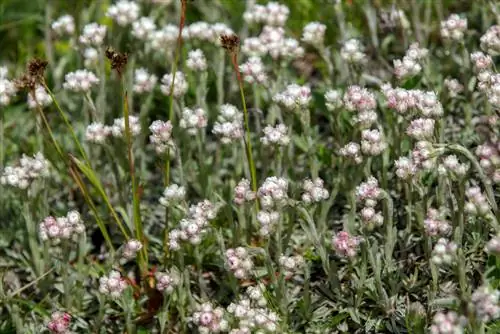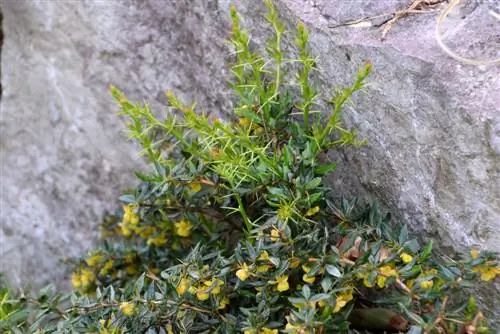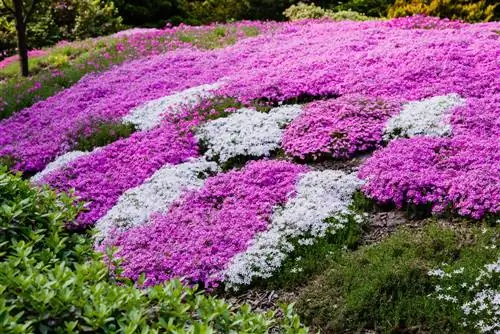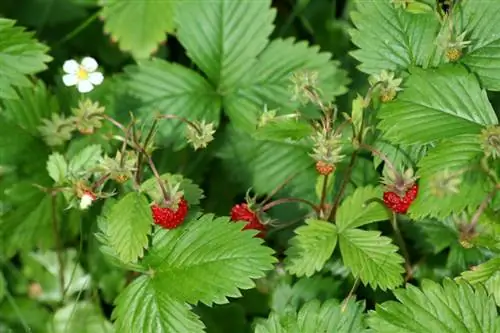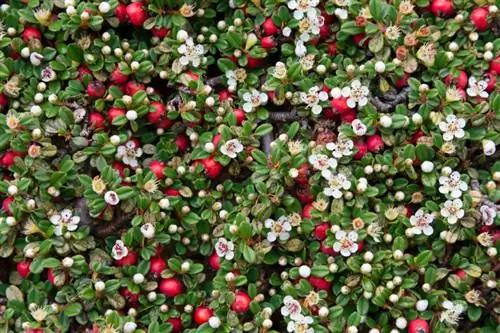- Author admin [email protected].
- Public 2023-12-16 16:46.
- Last modified 2025-01-23 11:22.
Their delicate flowers are reminiscent of cat paws, which left countless pink or white traces in the bed. Complemented by shimmering silver foliage, Antennaria conjure up dense soil cushions in all sunny, lime-poor locations in the garden. The following answers to frequently asked questions explain how the friendly flower looks in cultivation.
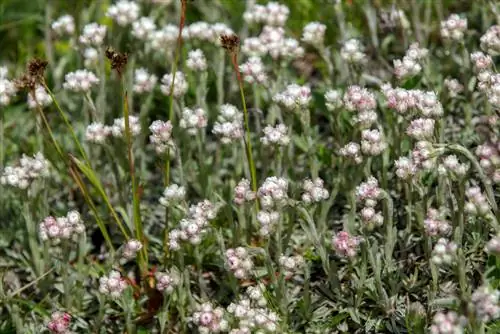
How do I care for cat paws (Antennaria) in the garden?
Cat paws (Antennaria) are hardy, easy-care plants that thrive in sunny, warm and protected locations with low-lime, permeable soil. They require little water and fertilizer and can be propagated by runners, division or sowing.
Planting cat paws correctly
Plant Antennaria preferably between August and October so that the plant starts its first garden season with a vital growth lead. Since a single cat's paw looks so lost in the bed, create 3-5 planting holes 20 cm apart. The excavated soil is enriched with a little compost and horn shavings (€52.00 on Amazon). Place a potted root ball in the middle and fill the gaps with substrate to just below the first pair of leaves. Pressing the soil and watering with soft water rounds off the planting process professionally.
Care tips
As the following care program reveals, Antennaria require little attention from the gardener:
- Water the flower only when it is dry with soft rainwater
- Fertilizing is not necessary
- Cut off wilted flowers just above the silvery foliage
- Complete pruning in February/March
No explicit winter protection is required in the bed. If the plant thrives in a pot or balcony box, wrap the container in foil or jute and place it on wood in front of the south wall of the house.
Which location is suitable?
Their floral lightness already signals the friendly flower's expectations of the location. It should be sunny, warm and protected there. Partial shade is tolerated well-naturedly, but results in a less magnificent flower bloom. Antennaria thrives on airy, loose, fresh to moderately dry soil that is ideally low in lime.
The correct planting distance
As is typical for a ground cover plant, Antennaria are more than twice as wide as they are tall. With a maximum growth height of 10 cm, the growth width is 20-23 cm. To ensure that the flower develops a dense carpet of flowers, planting at a distance of 20 cm is just right.
What soil does the plant need?
The charming plant likes to stretch out its roots in fresh, moist to sandy-dry soil, as long as there is little or no lime in it. First-class permeability is also considered a central criterion for successful cultivation. For a pot plant, we recommend rhododendron soil as a substrate, which is enriched with a handful of lava granules or perlite.
Cut cat paws correctly
The robust, winter-hardy cushion perennial does not require any pruning. If the withered inflorescences impair the visual appearance of the garden, there is nothing wrong with cutting them just above the decorative foliage. In early spring, pruning close to the ground clears the way for this year's budding. Cut off the most beautiful flower stalks when they are about to fully bloom and dry them in an airy place. As a dry bouquet you exude a pleasant scent in the house in autumn and winter.
Watering cat paws
Under normal weather conditions, natural rainfall covers water requirements. If summer comes with longer periods of drought, water the flower every now and then. Apply collected rainwater or decalcified tap water directly to the roots using a watering can early in the morning. If Antennaria thrives in a planter, there is a need for regular watering as the substrate dries out quickly. Check the soil every 2-3 days to water with soft water if the surface is dry.
Fertilize cat paws properly
The frugal plant prefers light, nutrient-poor soil. The administration of fertilizer is therefore not necessary. If you repot Antennaria in a pot or balcony box into pre-fertilized substrate every year, additional nutrient supply is also unnecessary here. If deficiency symptoms occur, such as stunted growth or fading colors, administer a commercially available liquid fertilizer in diluted concentration.
Wintering
Behind their graceful appearance lies a hardy constitution. Antennaria can easily tolerate temperatures down to -28.8 degrees Celsius. This means that no measures need to be taken for overwintering in the bed. However, if the flower thrives in the planter, the following precautions must be taken to ensure that the root ball does not freeze:
- Cover the bucket with bubble wrap or decorative, colorful jute ribbons before the start of winter
- Place on a block of wood or a Styrofoam plate in front of the south wall of the house
- Cover the substrate with wood wool, peat or autumn leaves
Carry containers with a diameter of less than 30 cm to a frost-free, bright winter quarters. Despite the protective measures mentioned, the small substrate volume cannot protect the plant from damage.
Propagate cat paws
Antennaria once again demonstrate their uncomplicated nature when it comes to reproduction. To plant additional specimens in other locations in the garden, choose one of the following methods:
- Separate rooted runners after flowering and plant them
- Dig up and divide the root ball in autumn or spring
- Sowing the fine seeds behind glass from March; At 20 degrees Celsius, germination begins within 2 weeks
Direct sowing is also possible, although the chances of success are lower. In contrast to cultivation on the windowsill, the seedbed outdoors is subject to the effects of weather, pecking birds and voracious pests.
Cat's paws in the pot
As a solitary plant or under planting, Antennaria in pots create shimmering accents on the sunny balcony and the light-flooded terrace. Ideally choose peat or rhododendron soil as a substrate, optimized with lava granules or expanded clay. A curved pottery shard above the water drain prevents life-threatening waterlogging. This is how care runs in a regulated manner:
- Only water when the soil has dried to a depth of 2 cm
- Cut off withered flower stems until just above the foliage
- When repotting into fresh substrate every year, no fertilization is necessary
Before the first frost, move the small pot to a bright winter quarters. Larger buckets are placed on wood in front of the protective south wall of the house and covered with bubble wrap.
Is cat paws poisonous?
Just looking at the botanical classification of the daisy family gives the all-clear regarding toxic content. Antennaria poses no he alth risk, neither to humans nor to animals. On the contrary, the plant was used in ancient times as a medicinal plant against snake bites or bronchitis.
Beautiful varieties
- Red Wonder: Umbrella panicles formed from dark red flower heads rise above shimmering silver foliage; 5-15cm
- Woolly Cat's Paw: Forms dense ground cushions with woolly white hairy foliage under white flowers; 5-10cm
- Rubra: Warmth-loving top variety that stands out with red-silver flowers and green-silver leaves; 3-10cm
- Borealis: Abundantly flowering Antennaria, whose delicate pink flowers appear tinged with white; 5-10cm

